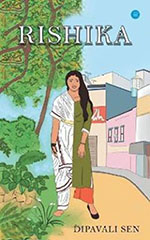An unusual theme coming from a talented writer made me hold the book in my hand and turn it around staring in bewilderment at the arresting title and also the cover design that depicts a woman clad half in an ancient garment and half modern. I started reading, turning the pages with avid rapidity. Six stories from the Hindu scriptures embellished with vivid descriptions and garnished with twists to suit the mood of the protagonist, Ila, kept me riveted. It took me on a journey extraordinaire to relive the lives of six strong-in-spirit women sages known as the rishikas. Their male counterparts, the rishis, are more in number and their stories are better known.
Ila is a twenty-first century young working woman, single, living alone, having had her struggles in dealing with men in her life so far. As we read along with Ila, it dawns on us that the stories are not just a recap of Upanishadic incidents but a staggering journey bridging ancient times and the present through the eyes and mindset of Ila. To read how the value systems in the lives of the rishikas bear an uncanny resemblance to that of Ila takes one’s breath away.
A wave of pathos engulfs us as we experience Ila’s predicament in the opening pages. But we are soon introduced to the inimitable Rishika Gargi as Ila starts reading her story. The dialogue between Gargi and Yajnavalkya is well known. Both endowed with a splendid gift of repartee carry on an edge-of-the-seat discussion that is presented by the author in crisp, fleet-footed prose. Gargi realizes she is one notch down as against Yajnavalkya’s knowledge and accepts defeat with dignity. Her father welcomes her back home with not a shade of annoyance, but with fatherly affection. Yet, surprisingly, she suddenly asks him: ‘Do you ever feel bad, father, that you don’t have a son, only a daughter that is me?’ Her father answers promptly with a benign smile: ‘You are worth two sons to me.’
Does the answer satisfy Gargi, or for that matter, Ila? This query and more are answered as we continue to read Gargi’s tale and sigh at the strange twist at the end of it. We pause to ponder with Ila and draw parallels and distinctions in her life and Gargi’s. Ila gets interested in drawing more such parallels. She reads on, taking the eager reader along with her. This time it is the story of Apala. She reads ‘not about Apala but as Apala’. The striking similarity between Apala’s life and Ila’s tugs at the emotional strings of the reader. No matter how far apart in time women lived, their agonies and ecstasies seem to match in one way or another, in varying degrees.
The story of Shavari from the Ramayana that Ila reads next is an endearing tale of utmost faith and devotion of a poor tribal girl to Lord Rama, steadfast till the fag end of her life on earth. Having met Rama, she passes on joyfully. What parallel would Ila have to draw out of it? Well, she does have something to put across to the reader.
It is past midnight when she begins to read about another rishika from the Ramayana named Swayam Prabha. She is not only intrinsically incandescent, but extrinsically also she spreads light around her, guiding and helping others. No doubt an interesting tale with the evergreen, lovable hero Hanuman and his monkey brigade interacting with Swayam Prabha, taking her advice and guidance. She herself exhibits her super-human, apsara-like talents. As we come to the end of the tale, we look forward to reading about the connection that Ila’s life has with Swayam Prabha’s activities.
After a short nap, Ila reads again, this time about Sujata, daughter of the wise Sage Uddhalaka. She has a difficult time blooming into womanhood, being the only female in her father’s ashram that housed several male disciples. She liked her father’s teachings and got a good grasp of it. He, too, treated her as his disciple in no way less than her male counterparts. In fact, she would be the rishika to manage the ashram after him. But, falling in love with her classmate leads her into a quagmire of problems. She manages to wriggle out of it with some creative help of the writer’s pen. In addition, it makes Sujata’s story somewhat akin to Ila’s.
In conclusion, Amba’s story as the pièce de résistance projects her as a different kind of rishika. The rishikas in the stories so far did not avenge the unfair treatment meted out to them. But Amba is quite different. She rebels against her fate and vows to avenge the wrong done to her. A gripping tale from the Mahabharata, indeed! In contrast, this time, there is no parallel that Ila draws from Amba’s life. She is not going to avenge the wrong done to her except making an early Will to protect her son.
Finally, Ila admits that she had been pursuing her career as a penance like any one of those ancient rishikas. ‘There was no specific rishika whose life was exactly like hers. But there were elements of all of them alive in her despite the centuries that separated them…and that is why their stories had grown into her own experience’, says the author.
November 2023, volume 47, No 11

